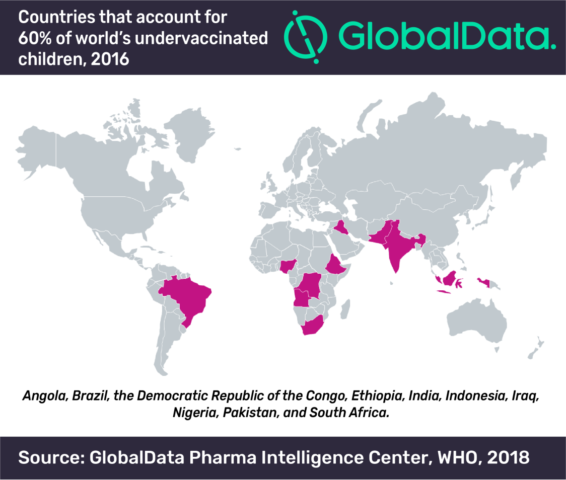Each year, the World Health Organization (WHO) uses World Immunization Week, celebrated during the last week of April, to promote awareness of the countless benefits of vaccines, which are undeniably the world’s most effective and economically sound medical intervention, says GlobalData, a leading data and analytics company.
The theme of World Immunization Week 2018—’Protected Together, #VaccinesWork’—highlights the need to improve pediatric vaccination rates globally, as the WHO estimates they have been stuck at 86% (116.5 million infants) over the past year.
Despite a coordinated effort to boost coverage rates over the past decade, the WHO states that 19.5 million infants still do not have access to vaccines that protect against life-threatening yet easily preventable diseases such as diphtheria, tetanus, pertussis (whooping cough), hepatitis B, measles, mumps, rubella, polio, and rotavirus. Approximately 60% of these undervaccinated children reside in only 10 countries, namely: Angola, Brazil, the Democratic Republic of the Congo, Ethiopia, India, Indonesia, Iraq, Nigeria, Pakistan, and South Africa.
Christopher J. Pace, GlobalData Director of Infectious Diseases, commented, ‘‘Overall, we believe that a strong patient-provider relationship, coupled with public awareness campaigns that tout the benefits of vaccination while simultaneously debunking anti-vaccine beliefs, is essential to bridging these diverse coverage gaps across the developing and developed world.’’

The WHO and its partners hope to improve vaccination rates in the developing world through targets set by the Global Vaccine Action Plan (GVAP). However, a 2017 status report revealed that progress toward achieving these goals by 2020 is behind schedule.
Pace added, ‘‘In contrast to the developing world, remaining immunization coverage gaps in developed countries such as the US are largely centered on adolescents and adults, who often receive the first dose of a recommended vaccine but then fail to follow up with their healthcare providers.’’
For example, the US Centers for Disease Control and Prevention (CDC) reported that while over 60% of eligible teens received ≥1 dose of the human papillomavirus (HPV) vaccine, only 49% and 37% received ≥2 and ≥3 doses, respectively, in 2016. A similar trend was observed with the adolescent meningitis (MenACWY) vaccine, as only 39% of eligible US teens received the complete two-dose series despite over 80% receiving the first dose.
About GlobalData
4,000 of the world’s largest companies, including over 70% of FTSE 100 and 60% of Fortune 100 companies, make more timely and better business decisions thanks to GlobalData’s unique data, expert analysis and innovative solutions, all in one platform. GlobalData’s mission is to help our clients decode the future to be more successful and innovative across a range of industries, including the healthcare, consumer, retail, financial, technology and professional services sectors.
